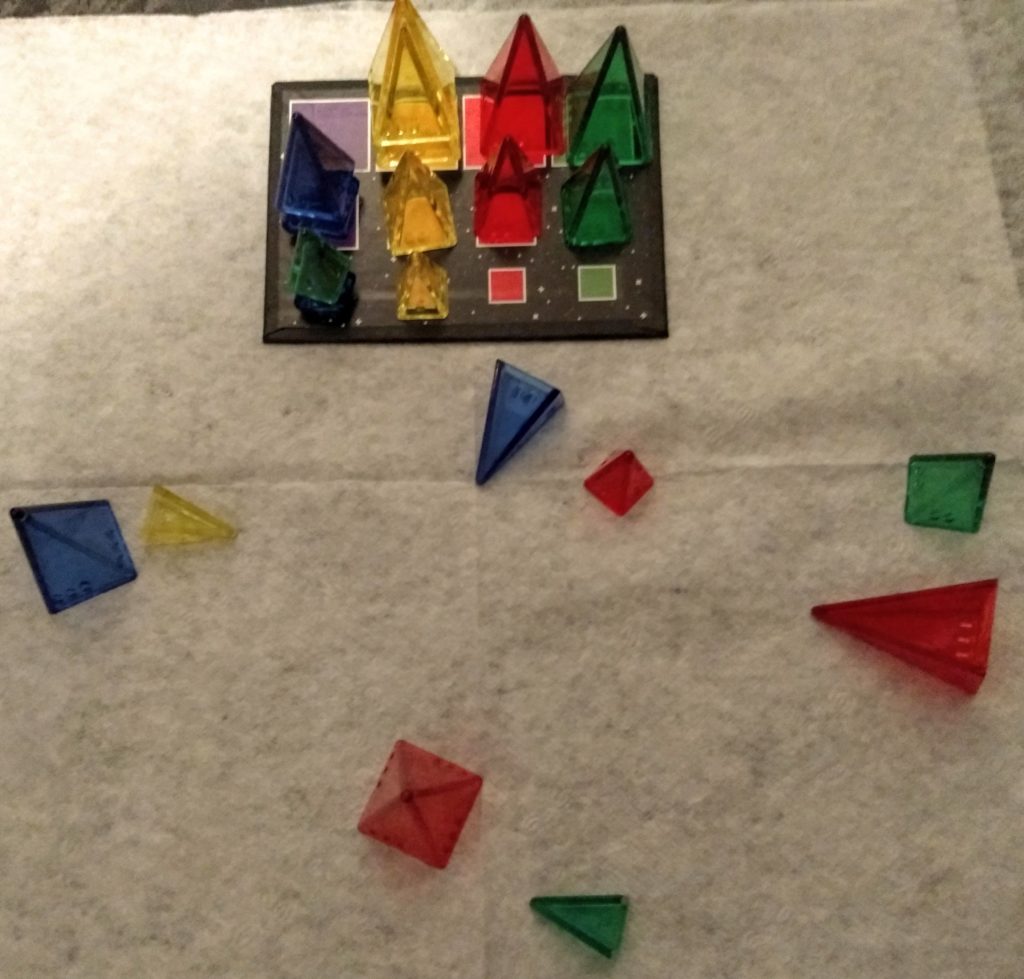Unplugged: Homeworlds (Boardgame)
/pic5241326.jpg) Loony Labs has two solid game lines going for it. One is the chaotic but entertaining line of Fluxx games, and the other is its line of games based around a set of of colored plastic pyramids. Sold in many different ways, the pyramid line is now available in several small box releases. Homeworlds, reviewed here, is probably the deepest and most strategic of the games released. In a sort of space-chess way, the pyramids in the game represent ships and planets, with each color of pyramid granting a player different powers when used. The goal of the game is to mess with the enemy player’s homeworld and trigger a win.
Loony Labs has two solid game lines going for it. One is the chaotic but entertaining line of Fluxx games, and the other is its line of games based around a set of of colored plastic pyramids. Sold in many different ways, the pyramid line is now available in several small box releases. Homeworlds, reviewed here, is probably the deepest and most strategic of the games released. In a sort of space-chess way, the pyramids in the game represent ships and planets, with each color of pyramid granting a player different powers when used. The goal of the game is to mess with the enemy player’s homeworld and trigger a win.
Homeworlds
Designer: John Cooper
Publisher: Looney Labs
Players: 2
Ages: 10+
Time: 15-60min
(review copy provided by publisher)
First, a brief explanation of the pyramid system. Like a deck of cards, Looney Labs pyramids can be thought of as the building blocks for many different games. Pyramids come in many different colors, each appearing as a set of stackable pyramids of three different sizes, called a “trio”. The pyramids also have pips on them, with the largest pyramids having 3 pips, mediums 2 pips, and the smallest having a single pip. There are freely available rules for dozens of games that can be played with the appropriate number and colors of pyramids. (I highly recommend Zendo, which is like the old color-guessing game of Mastermind, only ramped up a notch.) Homeworlds is part of a new line of small-box games that contain everything needed to play one (or two, in this case) specific games. However, the pyramids from several of these small-box games could be combined to play many of the other pyramid games.
:strip_icc()/pic5534762.jpg)
There is no board in Homeworlds, instead it is an ever-changing field of stars and ships. Upright pyramids represent stars, pyramids on their sides represent ships. (Since everyone uses the same pieces, ship owners are identified by the direction the ships are pointing.) Players’ starting systems are called their Homeworld and are represented by star systems of two colors (pyramids) instead of just one. The flow of the game centers around the colors of the pyramids. The four colors of pyramids are paired with four possible actions. Green creates new ships, yellow moves ships around, red captures other ships, and blue swaps out one color ship for another. On a standard turn, a player will execute an action from a system where they control a ship. The action can be based on the ship color or the system color. A player may choose instead to sacrifice one of their ships, gaining as many actions as pips on the ship. This also allows players to use that color action in any system (whereas an action is typically limited to the specific system chosen.) A special situation, called overpopulation, occurs when there are four or more pieces of the same color in a system. This includes ships of either side as well as the star system itself. At any point on their turn, a player can (but aren’t required to) call out a catastrophe on an overpopulated system. All pieces of that color are returned to the pyramid bank. If the star is one of those pieces, then ALL ships at that location are also returned to the bank. The game goes back and forth until one player manages to (a) control all enemy ships at the enemy’s homeworld, (b) destroy all enemy ships at the enemy’s homeworld via a catastrophe, or (c) destroy (via 2 catastrophes) both halves of the enemy player’s homeworld.

Verdict:
I love the pyramid system as they are both cool-looking on the table and highly versatile. I mentioned how much I enjoy Zendo and highly recommend it as an example of deductive reasoning. However, since games are essentially limited almost entirely to using just the pyramids, games are by necessity tend to feature abstract games with simple rules. (That doesn’t mean the games aren’t deep.) Homeworlds really takes the system to its limit, introducing a fairly complex and layered game of strategic and tactical depth. Despite the limited pieces it still somehow manages to pull off having an identifiable theme and avoids being a pure abstract. On the one hand, if I’m going for a meatier game I like to have a few more bells and whistles of options going on (like workers or resources) but on the other hand, Homeworlds has some nice depth to it. This is something that is not normally found in a box of this size. Since the pieces are all hardy plastic pyramids, one can easily play this while waiting for one’s food order or perhaps at a nice table in a coffee shop. In the meantime, it will stay in my collection as a great portable for a game of some depth.
Kid Factor
Homeworlds doesn’t require reading but the game is a thinker and may not be as kid-friendly. The listed 10+ years is actually pretty good, although younger but experienced gamers might be OK.





Discussion Area - Leave a Comment